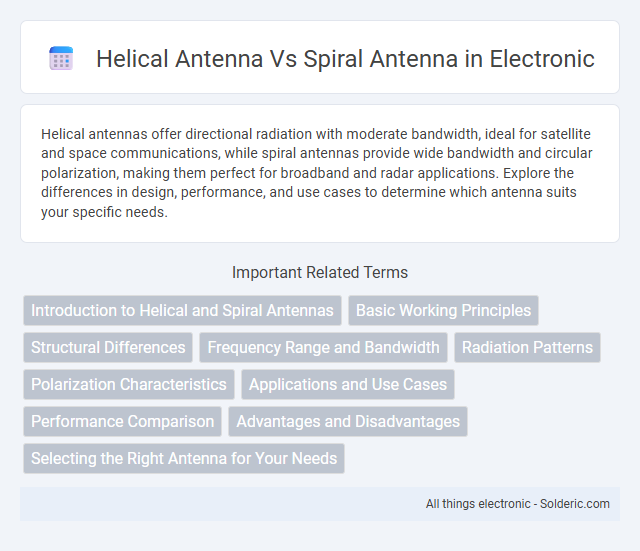Helical antennas offer directional radiation with moderate bandwidth, ideal for satellite and space communications, while spiral antennas provide wide bandwidth and circular polarization, making them perfect for broadband and radar applications. Explore the differences in design, performance, and use cases to determine which antenna suits your specific needs.
Comparison Table
| Feature | Helical Antenna | Spiral Antenna |
|---|---|---|
| Structure | 3D coil-shaped wire wound in a helix | Flat, spiral-shaped conductor on a plane |
| Frequency Range | UHF to microwave (300 MHz to several GHz) | Broadband, typically VHF to microwave (30 MHz to several GHz) |
| Polarization | Circular polarization (right or left-handed) | Circular polarization |
| Radiation Pattern | Directional beam along helix axis | Wide beamwidth, almost omnidirectional in plane |
| Gain | Moderate to high gain (up to 15 dBi) | Moderate gain (6 to 10 dBi) |
| Bandwidth | Narrow to moderate bandwidth | Ultra-wideband, often several octaves |
| Applications | Satellite communication, telemetry, GPS | Direction finding, radar, wideband communication |
| Impedance | Typically 140 Ohms (can be matched to 50 Ohms) | Usually 50 Ohms |
Introduction to Helical and Spiral Antennas
Helical and spiral antennas are both used for wideband and circularly polarized signal transmission and reception, with helical antennas featuring a wire wound in a helix shape and spiral antennas consisting of conductive arms spiraling outward on a flat plane. Helical antennas operate primarily in axial or normal modes, providing high gain and directional radiation patterns, whereas spiral antennas function as frequency-independent radiators with broadband, bidirectional patterns. Your choice depends on the specific application, frequency range, and radiation characteristics required for optimal performance.
Basic Working Principles
A helical antenna operates by transmitting and receiving circularly polarized electromagnetic waves through a helical coil, enabling directional radiation with a consistent axial mode. A spiral antenna, consisting of multiple conductive arms wound in a planar spiral, produces frequency-independent circular polarization by exciting traveling waves along its arms. Both antennas utilize the geometry of their coils to control wave propagation and polarization but differ in radiation patterns and bandwidth characteristics.
Structural Differences
Helical antennas consist of a single wire wound in a helix shape, typically mounted over a ground plane, enabling axial mode radiation with moderate bandwidth and directional gain. Spiral antennas feature multiple arms arranged in a planar spiral without a ground plane, providing wideband frequency response and circular polarization through traveling wave radiation. The structural configuration of helical antennas emphasizes a three-dimensional coil, while spiral antennas rely on a flat, planar geometry for broadband performance.
Frequency Range and Bandwidth
Helical antennas typically operate effectively within VHF to UHF frequency ranges, offering moderate bandwidth suitable for applications like satellite communication and radio astronomy. Spiral antennas provide ultra-wideband performance, covering frequencies from VHF through microwave bands, making them ideal for frequency-agile and broadband systems. Your choice depends on whether you prioritize the controlled directivity and gain of helical antennas or the broad frequency coverage and circular polarization of spiral antennas.
Radiation Patterns
Helical antennas exhibit a directional radiation pattern with a main lobe along the antenna's axis, providing high gain and circular polarization suitable for satellite and space communication. Spiral antennas produce a broad, nearly frequency-independent radiation pattern with circular polarization, ideal for wideband applications and signal intelligence. The helical antenna's focused beam contrasts with the spiral antenna's wide coverage, influencing their respective uses in communication systems.
Polarization Characteristics
Helical antennas exhibit circular polarization with a well-defined axial mode, ideal for satellite communications and GPS applications where stable polarization is crucial. Spiral antennas produce wideband circular polarization with a low axial ratio over a broad frequency range, making them suitable for electronic warfare and direction-finding systems. Your choice depends on the need for bandwidth and polarization stability, as helical antennas provide more focused circular polarization while spiral antennas offer broader frequency coverage with consistent polarization.
Applications and Use Cases
Helical antennas are widely used in satellite communication, GPS systems, and space telemetry due to their high gain and circular polarization capabilities. Spiral antennas find applications in wideband communication, electronic warfare, and direction-finding systems because of their broadband frequency response and compact size. Both antenna types are essential in modern wireless technologies, with helicals favored for focused directional signals and spirals for versatile frequency coverage.
Performance Comparison
Helical antennas excel in achieving high gain and circular polarization with a simpler design, making them ideal for satellite communication and space applications. Spiral antennas offer wide bandwidth and inherently broad beamwidth, suitable for ultra-wideband and direction-finding systems. Your choice depends on the need for gain versus bandwidth, with helical antennas favoring focused performance and spiral antennas providing versatility across frequencies.
Advantages and Disadvantages
Helical antennas offer high gain and circular polarization with a simple design, making them ideal for satellite communications but tend to be large and bulky. Spiral antennas provide wide bandwidth and frequency independence with a compact, planar structure, yet their lower gain and complex feeding mechanism can limit efficiency in certain applications. Both antenna types balance trade-offs between size, gain, bandwidth, and complexity depending on specific use cases like radar, wireless, or space communication.
Selecting the Right Antenna for Your Needs
Choosing between a helical antenna and a spiral antenna depends on your application's frequency range and radiation pattern requirements. Helical antennas provide directional radiation with moderate bandwidth, suitable for satellite communications and point-to-point links. Spiral antennas offer wide bandwidth and circular polarization, ideal for wideband applications like radar and electronic warfare.
helical antenna vs spiral antenna Infographic

 solderic.com
solderic.com